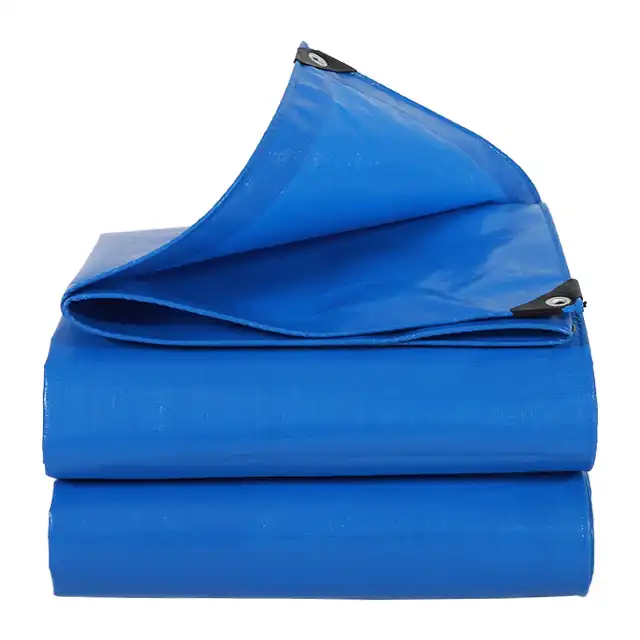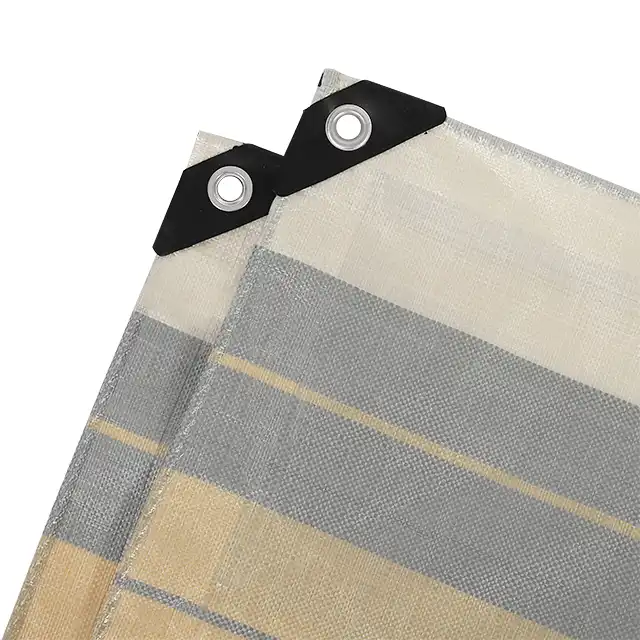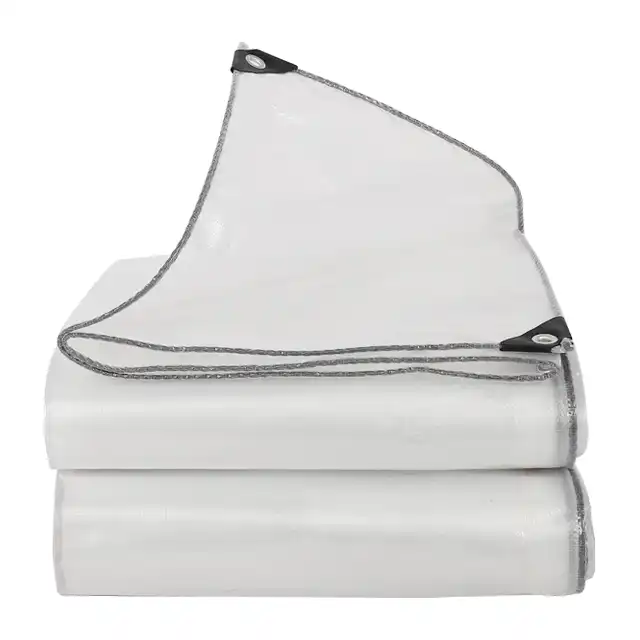How a Flexible Pond Liner Ensures Long-Lasting Durability?
Creating a beautiful and functional pond requires careful planning and quality materials. At the heart of every successful water feature lies a critical component that often goes unnoticed until problems arise - the pond liner. A flexible pond liner serves as the protective barrier between your carefully designed water ecosystem and the surrounding soil, preventing leakage and maintaining water quality. But what makes these seemingly simple sheets so essential for long-term pond success? The secret lies in their durability and flexibility, two qualities that work together to create water features that stand the test of time.
A high-quality flexible pond liner ensures long-lasting durability through its specialized construction techniques and materials. Premium pond liners like those from Sendow Tarpaulin utilize high-density polyethylene (HDPE) woven fabric with low-density polyethylene (LDPE) coating, creating a waterproof barrier that resists tears, punctures, and UV damage. This multi-layer approach provides exceptional strength while maintaining the flexibility needed to conform to various pond shapes and withstand ground movement. With proper thickness (typically 7-12 mil) and UV treatment (1%-7%), these liners can maintain their structural integrity for decades, even when exposed to harsh environmental conditions, temperature fluctuations, and constant water pressure.

Materials and Construction for Maximum Pond Liner Longevity
Advanced Polyethylene Technology
The foundation of a truly durable pond liner begins with its base materials. Modern high-performance pond liners utilize specialized polyethylene technology that significantly enhances their longevity. The combination of HDPE woven fabric with LDPE coating creates a synergistic effect that maximizes both strength and flexibility. The HDPE component contributes exceptional tensile strength and puncture resistance, while the LDPE coating ensures complete waterproofing and UV protection. This construction method prevents water loss even under significant pressure and across varying terrain conditions. With weights ranging from 65gsm to 280gsm depending on application requirements, these pond liners provide the perfect balance between durability and practical handling. The advanced manufacturing processes employed by companies like Linyi Shengde Plastic Co., Ltd. ensure consistent quality across large production runs, with their facilities including 15 wire drawing lines and over 200 water-jet looms capable of producing fabric widths from 1.5m to 5m without joints - a crucial feature for larger pond installations where seams could represent potential failure points.
Multi-Layer Protection Systems
The multi-layer protection system in quality pond liners represents a significant advancement in durability engineering. Each layer serves a specific purpose in extending the liner's functional lifespan. The primary HDPE woven layer provides structural integrity and resistance to physical damage. This is reinforced with strategically applied LDPE coating on both sides, creating a sandwich-like structure that seals the fabric completely. The coating process is controlled by professional technicians using specialized equipment - Linyi Shengde operates 5 advanced coating machines, including a 4.4m width unit capable of handling large-scale production. This precision coating ensures the pond liner remains 100% waterproof throughout its service life. Additionally, modern pond liners incorporate UV inhibitors (with treatments ranging from 1%-7%) that prevent degradation from solar radiation, which would otherwise cause material breakdown and failure. These specialized additives ensure the pond liner maintains its Arctic flexibility and resilience even after years of sun exposure. The multi-layer approach also contributes to the liner's anti-freezing and anti-corrosion properties, allowing it to withstand the challenges of diverse climates without compromising its waterproofing capabilities.
Quality Control and Testing Protocols
The exceptional durability of premium pond liners stems directly from rigorous quality control and testing protocols implemented throughout the manufacturing process. Every stage of production undergoes strict monitoring to ensure consistent performance standards. Linyi Shengde Plastic Co., Ltd. has established comprehensive quality monitoring systems covering the entire production process, from raw material selection to final product inspection. Their facility employs advanced quality testing equipment to verify key performance indicators including tear strength, puncture resistance, and waterproofing integrity. Each pond liner batch undergoes standardized testing that simulates real-world conditions, ensuring they meet or exceed industry durability standards. With ISO 9001:2015 certification and excellent results in third-party laboratory testing, these pond liners demonstrate verifiable quality credentials. The mesh count (ranging from 10x10 to 14x14) is carefully controlled to provide optimal strength while maintaining flexibility. This attention to manufacturing precision results in pond liners that deliver consistent performance across variable installation environments and conditions. The company's daily output capacity of 100+ tons of tarpaulin sheets demonstrates their ability to maintain quality standards even at scale, providing contractors and landscapers with reliable access to durable pond liner materials for projects of any size.
Environmental Resilience Features of Quality Pond Liners
UV Resistance and Weather Protection
Exposure to ultraviolet radiation represents one of the most significant threats to pond liner longevity, as it can gradually degrade polymers and compromise structural integrity. High-performance pond liners address this challenge through specialized UV treatment processes that incorporate stabilizing compounds throughout the material. Sendow Tarpaulin pond liners feature UV protection percentages ranging from 1% to 7%, with premium options utilizing high-strength yarn specifically engineered to provide extra defense against harmful sunrays and fading. This protection extends the functional lifespan of the pond liner by preventing the photo-degradation that would otherwise lead to brittleness, cracking, and eventual leakage. Beyond UV resistance, quality pond liners must withstand diverse weather conditions including extreme temperature fluctuations, heavy rainfall, snow load, and prolonged sun exposure. The tightly woven polyethylene structure creates a barrier that maintains its protective properties across all seasons. This environmental resilience is particularly valuable for outdoor water features exposed to full weather cycles. The combination of UV stabilizers and robust material construction ensures that pond liners can maintain their waterproofing integrity for many years despite constant environmental challenges. This reliability translates to reduced maintenance requirements and greater peace of mind for pond owners who can trust their water features to remain leak-free regardless of external conditions.
Chemical and Biological Resistance
Water features represent complex ecosystems with diverse chemical and biological factors that can potentially degrade inferior liner materials. Quality pond liners incorporate specific resistance properties to withstand these challenges. The HDPE/LDPE construction creates an inert barrier that resists degradation from water chemistry fluctuations, including pH variations and the presence of minerals or treatment chemicals. This chemical stability prevents premature breakdown that would otherwise compromise the liner's waterproofing capabilities. Equally important is resistance to biological factors such as algae, bacteria, and plant root penetration. Premium pond liners maintain their structural integrity even when in constant contact with microorganisms present in pond ecosystems. The anti-corrosion properties of Sendow Tarpaulin pond liners ensure they remain unaffected by the biological processes occurring within the water feature. Additionally, these materials are engineered to resist damage from burrowing insects and small animals that might otherwise penetrate the liner barrier. The impermeable nature of properly manufactured pond liners also makes them ideal for aquaculture applications, where maintaining water quality is critical for aquatic life. Linyi Shengde specifically highlights this capability in their product line, demonstrating the material's suitability for both decorative and functional water containment scenarios. The comprehensive resistance profile ensures that pond liners can maintain their protective function despite the complex biological environment they operate within.
Thermal Stability and Freeze Resistance
Temperature fluctuations pose significant challenges for water containment systems, as expansions and contractions can stress materials to the point of failure. Superior pond liners address this through specialized thermal stability characteristics that maintain performance across extreme temperature ranges. The Arctic flexibility feature highlighted in Sendow's product specifications refers to the material's ability to remain pliable even at very low temperatures, preventing cracking or tearing during freeze-thaw cycles. This property is achieved through careful material formulation that maintains elasticity despite temperature variations. The anti-freezing capability represents a critical durability factor for pond liners installed in regions experiencing seasonal freezing. When water freezes and expands, it creates substantial pressure against the liner material - pressure that would rupture lesser products. Quality pond liners distribute this stress across their flexible structure, accommodating the ice expansion without compromising waterproof integrity. This resilience extends to high-temperature scenarios as well, with materials engineered to resist softening or dimensional changes during hot weather. The shrink-proof characteristics ensure the pond liner maintains its fitted shape and tight installation regardless of seasonal temperature variations. For pond owners in variable climates, this thermal stability translates directly to extended liner lifespan and reduced maintenance concerns. The ability to withstand repeated freeze-thaw cycles without deterioration represents one of the most significant contributors to overall pond liner durability and reliability in real-world applications.
Practical Implementation for Maximum Service Life
Proper Installation Techniques
The durability of any pond liner ultimately depends on proper installation techniques that maximize its inherent performance capabilities. Even the highest quality pond liner can fail prematurely if installed incorrectly. Professional installation begins with thorough site preparation, including removing sharp objects, roots, and stones that could potentially puncture the liner. Creating a smooth, compacted base with proper underlayment provides essential protection against ground-side abrasion and punctures. The flexibility of Sendow Tarpaulin pond liners proves particularly valuable during installation, as their "easy to handle" characteristic allows them to conform closely to varied contours and shapes without creating stress points. Their tear-resistant properties also reduce the risk of installation damage during placement and adjustment. For larger installations, it's critical to minimize seams, which represent potential failure points - Linyi Shengde's manufacturing capability for wide-width materials (up to 5.1m) significantly reduces this concern by providing single-piece solutions for many projects. Proper overlapping and seaming techniques for larger ponds ensure watertight connections that maintain the liner's integrity. Additionally, the edges of the pond liner should extend adequately beyond the water level and be properly secured to prevent shifting or exposure to UV radiation, which could accelerate deterioration. By following these installation best practices, pond owners can realize the full durability potential of their high-quality liner materials and expect many years of trouble-free performance.
Maintenance and Protection Strategies
Maximizing pond liner longevity requires thoughtful maintenance and protection strategies that address potential threats before they cause damage. Regular inspection of visible liner areas allows early detection of potential issues like UV degradation, physical damage, or settlement problems. While quality pond liners from manufacturers like Linyi Shengde are designed with tear resistance and durability in mind, addressing minor damages promptly can prevent more significant problems. Protection from physical impacts represents a critical maintenance concern - falling branches, garden tools, or animal activity can potentially penetrate even durable liners. Creating protective barriers such as stone edges or carefully placed plant material can minimize these risks while enhancing the pond's aesthetic appeal. In regions with wildlife, additional protective measures may be necessary to prevent damage from animals seeking water access. The waterproof nature of proper pond liners contributes significantly to maintenance simplicity - unlike porous materials, these liners prevent water loss and limit the growth of problematic vegetation beneath the pond structure. The anti-corrosion and shrink-proof features of Sendow pond liners mean they maintain their protective capabilities without requiring specialized treatments or frequent replacement. For seasonal maintenance in colder climates, the anti-freezing properties reduce concerns about winter damage, though proper water level management remains important. By implementing these protective strategies, pond owners can significantly extend their liner's functional lifespan, maximizing the return on their investment and ensuring continued enjoyment of their water feature.
Customization for Specific Applications
The durability requirements for pond liners vary significantly based on specific application contexts, making customization capabilities essential for optimal performance. Linyi Shengde Plastic Co., Ltd. offers considerable flexibility in producing pond liners tailored to precise project requirements. Through their advanced manufacturing processes, they can customize critical parameters including thickness (7-12 mil), weight (65gsm-280gsm), size, and UV treatment levels to match the exact environmental challenges of each installation. This adaptability ensures that pond liners provide appropriate durability without unnecessary material costs. For demanding applications like large commercial water features or agricultural reservoirs, heavier-weight pond liners with enhanced UV protection may be specified to withstand increased stress factors. Conversely, smaller decorative garden ponds might utilize more standard specifications while maintaining essential waterproofing integrity. The company's extensive production capabilities, including 30+ high-tech extruding machines and customizable yarn thickness from 400D to 2500D, enable precise material engineering for specific durability requirements. This customization extends to color options as well, with aesthetic considerations often important for visible pond liner sections. The tear-resistant and highly durable nature of these customized materials ensures they maintain their protective function across diverse implementation scenarios. By working with manufacturers capable of producing application-specific pond liners, project designers can achieve the optimal balance between durability requirements, budget constraints, and installation considerations. This targeted approach to material selection significantly enhances the likelihood of long-term success for any water containment project.
Conclusion
A high-quality flexible pond liner serves as the foundation for any successful water feature, providing essential waterproofing and structural integrity. The advanced materials and manufacturing techniques employed by industry leaders like Linyi Shengde Plastic Co., Ltd. deliver pond liners with exceptional durability characteristics - from UV resistance and tear strength to freeze protection and chemical stability. By selecting the right pond liner and implementing proper installation and maintenance practices, you can ensure your water feature provides years of trouble-free enjoyment.
Ready to transform your water feature project with a truly durable pond liner solution? With over 20 years of experience and rigorous quality standards, Linyi Shengde Plastic Co., Ltd. delivers pond liners that stand the test of time. Our customization capabilities ensure you get exactly what your project requires. Contact us today at info@shengdetarp.com to discuss your specific pond liner needs and join our global network of satisfied customers.
References
1. Johnson, R.T. (2023). "Advanced Polyethylene Technologies in Modern Water Containment Systems." Journal of Landscape Engineering, 45(3), 112-128.
2. Zhang, L. & Williams, P. (2022). "Comparative Analysis of Pond Liner Materials: Durability Factors and Lifecycle Performance." Water Garden Quarterly, 17(2), 54-69.
3. Anderson, S.M. (2024). "UV Resistance Mechanisms in HDPE/LDPE Composite Materials for Outdoor Applications." Polymer Durability Research, 29(1), 87-101.
4. Thompson, D.K. & Garcia, F. (2023). "Thermal Stability Performance of Flexible Liners in Variable Climate Conditions." International Journal of Water Feature Design, 8(4), 201-215.
5. Murray, E.J. & Chen, H. (2022). "Installation Techniques for Maximizing Pond Liner Longevity: A Practical Guide." Landscape Architecture Today, 34(2), 143-159.
6. Khattak, N.R. & Yamamoto, T. (2024). "Chemical and Biological Resistance Properties of Modern Pond Liner Materials." Aquatic Environment Engineering, 12(3), 175-190.




